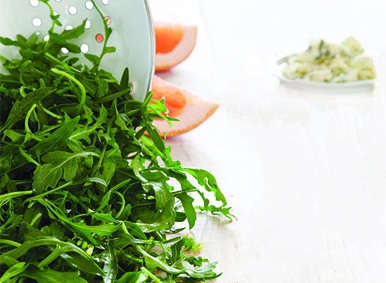
When it comes to nutrition, leafy greens are rock stars — they top the charts in vitamins A, C and K, potassium and fiber with only 5 to 40 calories per cup. Cruciferous vegetables such as kale, collards and cabbages are natural defenders recognized for their potential roles in cancer prevention. Kale, spinach and turnip greens are high in lutein, a phytochemical that may reduce the risk of age-related macular degeneration.
Though available year-round, winter greens like cabbage, collards, kale, turnip greens and mustards taste sweeter and are tenderer during the cooler months. Spring is peak season for chard, spinach and lettuces.
Leafy greens are versatile with many origins, flavors and culinary uses. Thorough cleaning is essential, so wash the greens in several changes of cool water to eliminate dirt. Fresh leafy greens will keep in the refrigerator crisper for three to five days. For extended storage, hardier greens can be blanched and frozen. Cooking greens will concentrate many of the vitamins and minerals and can help lessen bitter flavors. However, water-soluble nutrients such as vitamin C can be lost if the greens are cooked for too long or if the broth is discarded.
The Dietary Guidelines for Americans recommend consuming at least 1½ cups of dark green vegetables per week, so enjoy them frequently. But because of their high vitamin K content, large amounts of leafy greens may interfere with the effects of blood thinners like warfarin. Anyone taking these medications should consult with a doctor or registered dietitian nutritionist.
Collards — A hardy cruciferous vegetable popular in the Deep South, collards are an excellent source of fiber, vitamins A and K, and calcium. Phytochemicals present may help prevent some cancers and promote heart health. Collards’ leathery leaves demand longer cooking and respond well to braising or stuffing. Pair with vinegar and chili peppers to mellow collards’ bitterness.
Mustards — Native to the Himalayan region of India, mustards are one of the more pungent leafy greens with a characteristic spicy, peppery flavor. Mustards provide a hefty dose of vitamins A, C and K, calcium and fiber. Enjoy mustards braised, steamed or lightly dressed as a raw salad green.
Cabbage — The humble green cabbage is a fiber-rich cruciferous vegetable and excellent source of vitamins C and K. Eating cabbage regularly may help reduce the risk of certain cancers. Enjoy cabbage raw in slaw, steamed, stuffed or tossed into soup. Prevent the release of its smelly sulfuric compounds by cooking cabbage quickly.
Romaine* — One of the five lettuce types, romaine is a good source of folate and vitamin K. Tear (don’t cut) leaves to avoid the release of ascorbic acid oxidase, which destroys vitamin C. Best eaten raw, romaine is a perfect crunchy and refreshing salad base, sandwich topper or wrap.
Chard — Sometimes called “silverbeet” and available in several varieties, chard is a Mediterranean native. Chard provides vitamins A and K, magnesium, potassium and a particularly high level of sodium at 315 milligrams per cup. Young, tender chard can be eaten raw in salads. Mature chard cooks quickly and pairs well with lemon juice and olive oil.
Watercress* — Adored for its sharp, peppery bite, watercress is a member of the mustard family. Watercress is an excellent source of vitamins C and K. This green is best eaten raw. Add to salads or use as a sandwich green.
Kale — Popular in northern Europe and now throughout the U.S., kale is a nutrient-dense cruciferous vegetable. It’s an excellent source of lutein and vitamins A, C and K, and a good source of calcium. Choose kale with dark green, smallto medium-sized leaves free of any yellowing. Enjoy kale raw, braised, sautéed or in soup.
Spinach — A natural hydrator, raw spinach is 91 percent water. Spinach is an excellent source of vitamins A, C and K, folate, potassium and fiber. Because of its high water content, cooked spinach is significantly higher in these nutrients. Enjoy spinach raw in salad or sandwiches or cooked in soups, stews and side dishes.
Turnip Greens — With chart-topping lutein content, turnip greens are a nutrient powerhouse. One cup delivers more than 100 percent of the recommended daily amount of vitamin K and a third of daily vitamin C — and is an excellent source of fiber, vitamin A and calcium. Turnip greens are tender and can be enjoyed simply braised or sautéed.
Arugula* — Also known as “rocket,” this peppery salad green is a staple in Italian and Mediterranean cuisines. An excellent source of vitamin K, arugula is often eaten raw, where it does double duty as a “lettuce” and herb in salads. Arugula also can add spice to sandwiches and pasta dishes.
Escarole — Part of the chicory clan, escarole is a somewhat bitter green. Escarole delivers potassium and vitamins A and C. Though it can be eaten raw, cooking escarole softens its bitter edge. Because escarole maintains its volume and cooks quickly, this green is perfect for sautés, soups or in a warm white bean salad.
*Nutrient content is for raw greens. All others are 1 cup cooked greens.








